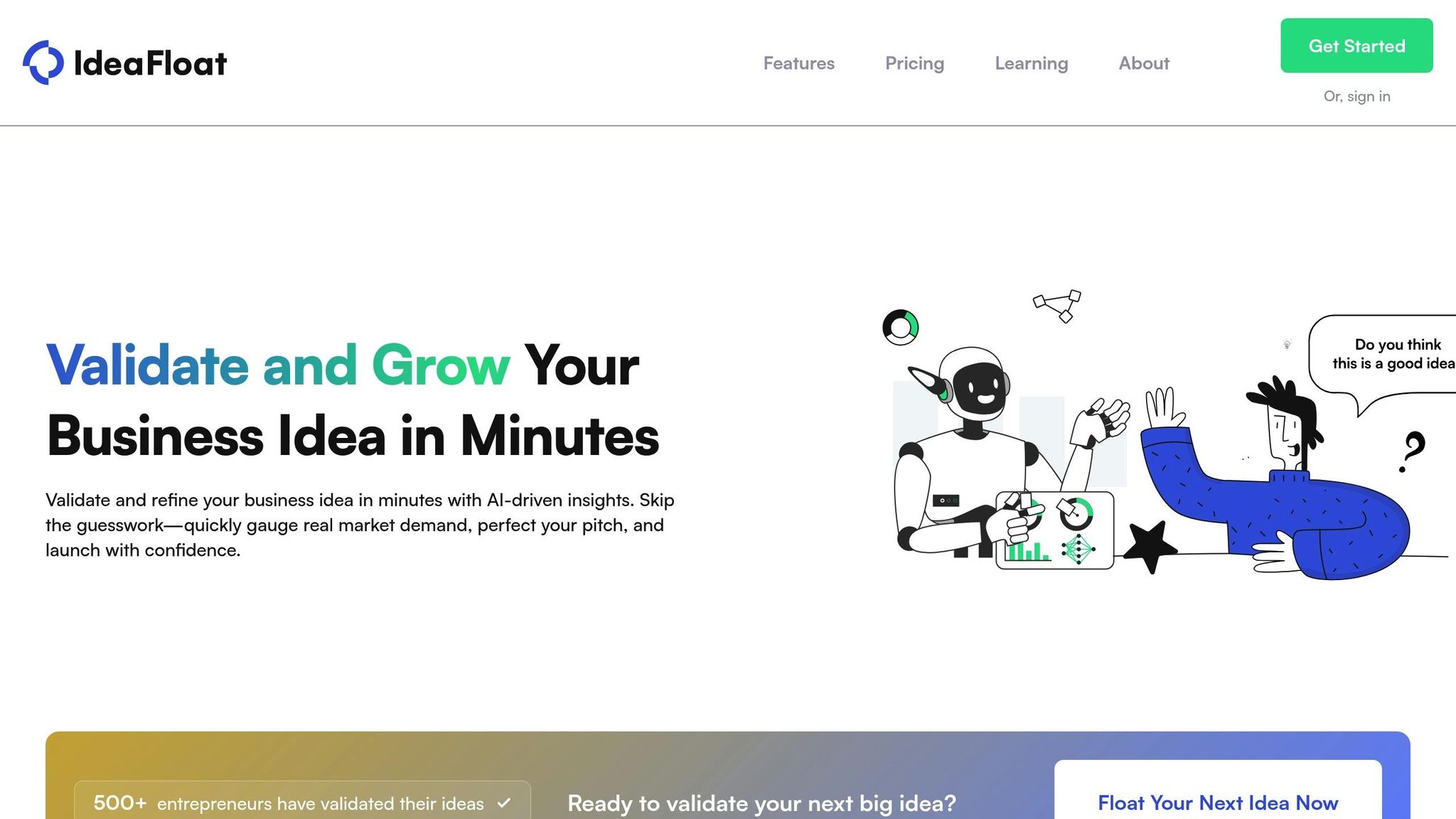
Successful business plans share clear strategies, measurable goals, and flexibility to adapt. After analyzing 1,000 plans, here's what stood out:
- Formal Planning Matters: Businesses with formal plans grow 30% faster, and 71% of fast-growing companies maintain their plans.
- Key Success Traits:
- Simple Plans for startups; detailed plans for established businesses.
- Regular goal setting and tracking boost growth by 30%.
- Financial models must be realistic and aligned with market research.
- Customer Feedback is Crucial: Engaging customers as partners drives repeat business and valuable insights.
- AI Tools Help: AI simplifies market research, competitor analysis, and financial modeling.
| Success Factor | Key Insights |
|---|---|
| Formal Planning | 152% higher likelihood of launching a business with a formal plan. |
| Market Analysis | Identify unmet needs, analyze competition, and validate market size. |
| Financial Projections | Include revenue, cash flow, and profit/loss forecasts. |
| Customer Feedback | Treat customers as partners for better alignment and growth opportunities. |
| AI for Research | Use tools for faster, data-driven decision-making. |
Takeaway: A strong business plan combines clear goals, actionable steps, and adaptability to market insights.
Success Elements in Business Plans
Writing Strong Executive Summaries
The executive summary is a critical part of any business plan, offering a quick yet thorough overview of your venture. As Clifford Chi explains:
"Your executive summary is the most important section of the entire business plan. It is an overview of and introduction to your entire project."
A well-structured executive summary typically includes three main parts:
| Component | Purpose | Key Elements |
|---|---|---|
| Problem Statement | Defines the market need | Current pain points, market gaps |
| Solution Overview | Explains the value offered | Key features, unique benefits |
| Financial Highlights | Demonstrates business potential | Revenue projections, growth metrics |
This section sets the tone for the rest of your business plan and lays a foundation for the market analysis that follows.
Market Analysis Requirements
A strong market analysis confirms the viability of your business idea by diving into industry data and trends. Clifford Chi suggests:
"When writing this section, start with the unmet needs your business addresses, including why current solutions fall short. Then, quantify your target market with verified data on market size, growth trends, and addressable segments."
Key elements of a market analysis include:
| Analysis Component | Required Elements | Purpose |
|---|---|---|
| Market Size | Total addressable market (TAM) | Shows the scale of opportunity |
| Customer Segmentation | Demographic and behavioral data | Identifies target audiences |
| Competitive Landscape | Direct and indirect competitor analysis | Highlights market positioning |
| Growth Trends | Industry forecasts and market drivers | Validates long-term potential |
This analysis not only strengthens your business case but also builds the foundation for creating realistic financial projections.
Creating Accurate Financial Models
Financial models are a cornerstone of any business plan, but they need to be based on realistic expectations. As Devra Gartenstein emphasizes:
"An investor who puts money into your business has the right to understand your company's financial potential to determine whether it is a worthy investment."
Strong financial plans include these three key components:
- Revenue Projections
- Offer monthly projections for the first year and quarterly projections for years two and three. These should align with your marketing plans and production capabilities.
- Cash Flow Analysis
- Break down revenue streams alongside expenses like operating costs, marketing, staffing, and capital investments. This helps clarify how funds will be managed.
- Profit and Loss Statements
- Detail income, cost of goods sold, operating expenses, and net profits. These statements provide a clear picture of your business's profitability.
The best financial models are consistent across all components and include clear explanations of growth assumptions backed by market research. This approach builds trust with potential investors while showcasing your business's potential.
Success Factors in Top Business Plans
Using AI for Market Research
Many top business plans rely on AI to test assumptions and gather useful insights. These tools use techniques like sentiment analysis, trend tracking, and demand forecasting to offer a clearer picture of market dynamics. Sai Blackbyrn, CEO of Coach Foundation, highlights the power of AI in this process:
"AI can analyze large volumes of data from various sources, including social media, customer feedback, online reviews, and market trends, to provide valuable insights into customer preferences, behavior, and market demand."
By leveraging these insights, businesses can better connect with their audience and set clear, actionable goals.
Getting and Using Customer Feedback
Incorporating customer feedback is a crucial part of successful business planning. Nick Nelson, President of CTW Logistics, emphasizes the value of treating customers as partners:
"By treating customers like partners, they begin to act like partners. Repeat and referral business is escalating, and customers are even introducing us to companies they think we should acquire."
Gathering and acting on feedback can involve direct conversations, regular feedback collection, quick implementation of changes, and follow-up communication. Bill Fotsch, Founder of Economic Engagement, explains the importance of this approach:
"Speaking with customers–not to sell them something, but to ask for their input–is an amazingly valuable activity that far too few companies take advantage of."
This customer-first mindset helps businesses align their goals with real-world needs.
Connecting Goals with Action Plans
Clear planning is essential for growth. Successful business plans tie together executive summaries, market analysis, and financial modeling with well-defined objectives and actionable steps. Regularly tracking progress and adjusting strategies based on feedback ensures that day-to-day actions stay aligned with long-term goals. This approach keeps businesses focused and adaptable as they move forward.
sbb-itb-08dd11e
Creating a Powerful Market Analysis for your Business Plan
Building an Effective Business Plan
Creating a solid business plan involves combining key components into a clear and actionable roadmap for success.
Key Elements of a Business Plan
A strong business plan should include the following:
- Executive Summary: A brief overview of your business goals and strategy.
- Market Analysis: Detailed research on your target market, customer needs, and competition.
- Financial Projections: Realistic numbers showing how your business will generate revenue and manage costs.
- Market Validation: Back up your ideas with customer feedback and research to confirm your assumptions.
- Action Steps and Risk Management: Outline clear steps to achieve your goals and strategies to address potential risks.
These components provide the foundation for a well-structured plan that aligns with your business priorities.
How IdeaFloat Simplifies Business Planning

IdeaFloat's AI-powered tools make business planning faster and more efficient. The platform helps with critical tasks like:
- Assessing market size
- Profiling customers
- Analyzing competitors
- Calculating startup costs
- Identifying breakeven points
- Optimizing pricing strategies
By handling these complex tasks, IdeaFloat helps you focus on refining your strategy and making informed decisions.
Traditional vs. AI-Driven Planning
Traditional business planning often requires extensive research and time. In contrast, AI-powered tools like IdeaFloat speed up the process by analyzing vast amounts of data and providing insights quickly. This approach not only saves time but also allows you to adjust your plan as market conditions change, ensuring your strategy stays relevant and effective.
Conclusion: Main Success Factors
Key Success Elements
After analyzing 1,000 business plans, some common traits emerge. Successful plans tend to have a clear strategy and a well-organized structure.
Here’s what stands out in the most effective business plans:
Strategic Planning Approach
- Clear goals paired with regular progress tracking
- Flexible frameworks that adjust to market changes
- Strong value propositions supported by thorough market research
- Realistic financial forecasts, including detailed breakeven analyses
Implementation Focus
- Documented feedback from customers
- Actionable steps directly linked to business goals
- Systems to monitor and evaluate performance
These insights can guide you in strengthening your business plan.
Next Steps with IdeaFloat
Use these success factors to refine your plan with IdeaFloat’s tools:
- Start with Core Elements
Create a solid foundation using IdeaFloat's Business Summary Generator. This AI-powered tool helps you quickly assess market size and build customer profiles in minutes. - Validate Your Concept
Test your idea with the Validate Score feature. This tool analyzes extensive data to deliver actionable insights for refining your business concept. - Build Financial Models
Use the Startup Cost Analyzer and Breakeven Analysis tools to develop accurate financial projections.
"Having a plan is less about accurately predicting the future, and more about setting regular goals, tracking your actual progress toward those goals and making changes to your business as you learn more about your customers." - Noah Parsons
Related Blog Posts
Get the newest tips and tricks of starting your business!


